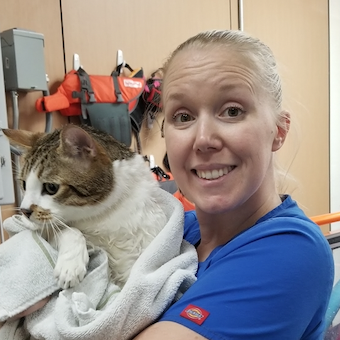In my nearly ten years in veterinary practice, I have encountered countless instances of gaslighting from management and colleagues. Gaslighting can have such a profound negative impact on one’s mental health, so we must learn what gaslighting is and how to manage it in the workplace.
What is Gaslighting?
The word “gaslighting” has become more predominant in conversation in the last few years.
But do we really know what it means, if it’s happening to us, and how to address it?
“Gaslighting” comes from a 1940 psychological film titled Gas Light.
In the film, a husband and wife move into their new home, and the woman notices that, among other strange happenings with misplaced and lost items, the lights in their home keep dimming. When she mentions this to her husband, he tells her that surely she must be imagining things; the lights are absolutely fine.
Moreover, she must have forgotten again where she put an item that now can’t be located. Throughout the movie, she comes to question her reality, and it’s eventually revealed that the husband was purposefully manipulating her; he was intentionally dimming the lights and moving items to convince her, for his own nefarious purposes, that she was out of touch with reality.
That she was crazy.
Merriam Webster defines gaslighting as “psychological manipulation of a person that causes the victim to question the validity of their own thoughts, perception of reality, or memories and typically leads to confusion, loss of confidence and self-esteem, the uncertainty of one’s emotional or mental stability, and a dependency on the perpetrator.”
How Do I Identify Gaslighting in My Veterinary Practice?
A Forbes article by Marissa Conrad describes the difficulty people have of actually identifying gaslighting in the workplace.
Many people find the concept of gaslighting confusing; this makes sense because gaslighting is ultimately meant to be confusing; it’s not always obvious to the individual being gaslit.
In fact, many employees are unaware they are being gaslit and wind up working in toxic work environments for years without setting boundaries for themselves.
Therefore, it’s essential to understand and recognize signs of gaslighting so you can identify them, address them, and advocate for yourself within your workplace.
Conrad’s list of common signs of gaslighting is as follows:
- You are being personally described, or your behavior is described as crazy, irrational, or overemotional.
- Feeling powerless and confused after an interaction with someone.
- Hot and cold behavior. A gaslighter will frequently include praise with their gaslighting, intentionally throwing off the victim.
- You are told you are exaggerating when addressing a concern or issue.
- The “Twilight Zone” effect: you feel the situation is unreal or surreal.
- Your memory of events is questioned even though you know you remember the events accurately.
- You are told one thing from the gaslighter, but their actions speak differently.
- You are given the impression your concerns are being listened to, but no resolution comes from your concerns, or no effort is made to address your concerns.
- Your concerns and feelings are trivialized.
Sounds pretty toxic. And it is. Gaslighting is emotional abuse.
When I first encountered gaslighting, I felt incredibly distraught, confused, powerless, and distressed. I felt anxious and depressed, doubted my self-worth, and questioned my abilities as a technician. At the time, I had no idea how to advocate for myself and felt stuck.
However, with the help of trial and error and having a mom who is a therapist (thanks, mom 😘), I’ve learned how to advocate for myself and free myself from the emotional abuse of gaslighting in veterinary hospitals.
If you’re feeling any of the symptoms and see the signs of gaslighting at your practice, here are some tips that could help you out.
How to Address Gaslighting in your Practice:
Be Careful with the “Work Family” Atmosphere
Have you ever worked at a veterinary hospital where they say phrases like “we’re a family?”
Staff is encouraged to view their colleagues as irreplaceable, family members, or a tight-knit team who get through challenging times together and are there for each other?
This camaraderie and closeness can be highly appealing, but it isn’t. Veterinary staff is frequently expected to stay long past their scheduled shifts if staffing shortages or an influx of intakes.
One day, I told my husband that I felt guilty because I left on time from an emergency veterinary hospital shift. I felt so bad I left my coworkers to deal with tons of emergencies. They were drowning in work. I left them ‘high and dry.
My husband stopped me and said, “This is not your responsibility or your burden to bear.”
I said, “I feel like I’m a bad worker for leaving them with so much work to do.”
He said, “Did you do your job during your shift hours?”
I replied yes.
“Then you are a good worker.”
This was a pivotal moment for me.
I equated going above and beyond to the point of exhaustion and compromised mental health to mean I’m a good employee when the reality was I was seeking validation from management who was willing to overwork their employees instead of addressing the staffing issue.
I thought about what my husband said and wondered what it would be like if all the employees at the vet hospital left on time for their shifts instead of staying hours late. If all the employees left on time, this would create an inevitable deficit in the staffing, which management would then be forced to address. Management wasn’t addressing the staffing needs because we were all willing to work late nearly every shift (regardless of how much we complained about it). I talked to a handful of my coworkers about this and asked if they were willing to leave on time from their shifts, and all I heard for responses was “Staying late is just the way it is in vet med” or “I don’t want the patients waiting for triage to suffer” or “I don’t want my coworkers to suffer.”
I discovered none of my coworkers were willing to consistently leave on time because they were either afraid of leaving their fellow technicians to drown in extra work or afraid the animals would suffer due to lack of care from understaffing. We as a team had become gaslit and conditioned to tolerate understaffing and expected to stay late every shift under the guise of supporting our work family and our love for animals.
Know Your Truth
My husband, a Registered Nurse, doesn’t buy into gaslighting. He recognizes it but doesn’t allow it to disrupt the boundaries he has set for himself about his workplace.
His typical shift is from 7 am - 7 pm, and he rounds the next shift of his current caseload until 7:30 pm. If he was frequently asked to stay until 9 pm (when he was scheduled until 7 pm) and then was told, “I thought you were a team player. Can’t you help us out? We are all tired and overworked here, we have to have each other’s backs” he’d already know what the truth was and say no. The truth is that he knows he’s a team player, knows he’s a caring healthcare worker, and he knows he values his colleagues.
He knows it’s not his responsibility to staff the floor and that to be a team player, he needs to be balanced with work/life and have healthy boundaries.
He understands that being a caring healthcare worker doesn’t mean making himself sick by burning out.
These conversations with my husband helped me realize that setting healthy boundaries for myself in the veterinary hospital despite worrying what my managers and colleagues would think of me was the best possible thing I could do for my mental health and my career. I knew my lack of workplace boundaries led me on a fast track to depression and burnout. Something had to change if I had any chance of staying in vet med long term.
I’ve determined the first step to addressing gaslighting in veterinary hospitals is to know your truth and expect to not be heard by your gaslighter.
Set Healthy Boundaries
It sounds counterintuitive to expect to not be heard by your gaslighter, but the feeling of powerlessness you may feel when talking to the person gaslighting you about issues comes from trying to be heard by someone who doesn’t want to or won’t hear you. It’s important to understand that you can set boundaries for yourself in the workplace without changing your gaslighter’s mind about their unethical practices or toxic work culture.
There is great power in establishing your boundaries regardless of what people think of you. Here’s the general conversation template I live by when setting my boundaries in the veterinary hospital.
Let’s use setting the boundary of not staying late every day as an example.
Let’s say you’re having a conversation with your practice manager, and they tell you it’s not acceptable for you to leave when your shift is over when new cases are coming in and that this is damaging to the team and the patients.
Acknowledge what they’ve said and their need: “So it sounds like you don’t think I’m a team player and that you really need me to stay late.”
State your reality and reaffirm your decision: ”However, I know I can be a great team player, and I have boundaries around my schedule, so I won’t be able to stay later to help.”
State your need: “If my schedule is going to be changed or you need me to stay late, I’ll need ___number of days ahead of time to make arrangements.”
Acknowledge them listening to you: “I appreciate you listening despite our difference of opinion regarding changing my schedule.”
Some general conversational responses for establishing your boundaries:
- “I realize you need extra help, but I won’t be available this evening/today/tomorrow.”
- “I know it might not make sense, but this is what I’m going to need to do.”
- “I have a boundary that I leave on time or only stay for ____minutes (fill in the blank) after my shift.”
- “I realize we have different versions of the situation, but I’ll have to go with what I remember.”
- “Regardless of how each of us remembers the previous discussion, I need to _______(fill in the blank).
- “Since we have different versions of what was discussed, I’ll need to re-discuss my needs/boundaries/parameters (etc.).
- “I’m very sure about what I discussed with you.”
- “Even though we remember the conversation differently, I still have my boundaries of _____(fill in the blank).”
Create a Healthier Work Experience in Vet Med
It can be scary and intimidating, and it takes bravery to stand up for yourself in a work environment filled with gaslighting. This is a learned skill that only gets better with practice.
Gaslighting is never okay.
It is emotional abuse designed to rob you of your boundaries and mental health. The majority of the people I’ve had the pleasure of working with over the years are some of the funniest, most genuine, hard-working, passionate, and creative people I’ve ever met.
All veterinary professionals deserve to continue to work in veterinary medicine with healthy boundaries that promote good work/life balance and stable mental health.
Always remember, your feelings are valid. You are deserving and capable of setting healthy boundaries for yourself at work. I see you, and I believe in you.
Want to learn more about bettering your rpactice culture? Read The Ultimate Guide to Awesome Culture in Veterinary Medicine




.gif)


